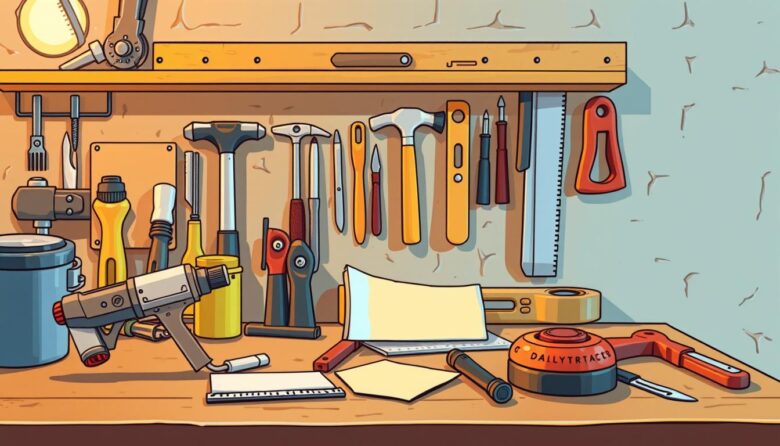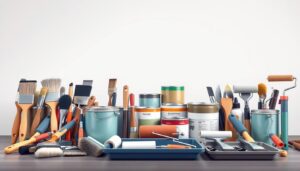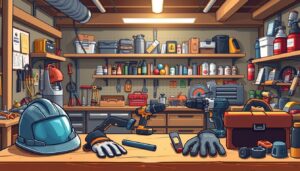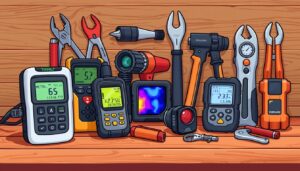Keeping your home in top shape is a key part of homeownership. Small issues like holes and cracks can appear over time. Having the right equipment on hand lets you tackle these problems quickly.
This guide highlights the seven most critical items for your DIY kit. You will learn how to handle common damage scenarios. This approach saves you both time and money on professional services.
We cover everything from basic putty knives to specialized compounds. Each tool plays a vital role in achieving a smooth, professional finish. Proper maintenance protects your property’s value and prevents minor issues from growing.
Our focus includes materials like drywall, plaster, and sheetrock. You will understand not just what to buy, but why each item matters. Get ready to build a toolkit that empowers you to maintain your home with confidence.
Introduction to Wall Repair Tools
Home maintenance inevitably includes dealing with various types of surface damage. These items help homeowners address common imperfections without professional assistance.
Basic homeowner kits differ from contractor-grade equipment. DIY enthusiasts need versatile, multi-purpose implements rather than specialized professional arsenals.
Common household situations require these implements. Picture hanging leaves small holes. Furniture impacts create dents. Settling causes fine cracks. Doorknobs occasionally mark surfaces.
The right equipment transforms intimidating projects into manageable tasks. Weekend fixes build practical skills and homeowner confidence. Modern products have simplified processes significantly.
These items fall into several categories:
- Application implements for spreading compounds
- Cutting and shaping devices for precise work
- Fillers and compounds for surface restoration
- Finishing equipment for smooth results
Quality investments pay dividends throughout homeownership. Recurring maintenance needs make having proper equipment essential. A focused collection delivers excellent results for most common situations.
Benefits of Using Professional Repair Equipment
Superior implements make the difference between amateur results and professional-looking finishes. Quality gear delivers superior outcomes compared to makeshift solutions that can worsen existing issues.
Well-designed items save significant time. They apply compounds smoothly and cut cleanly, achieving perfect results in fewer passes. This efficiency transforms weekend projects into quick fixes.
The investment pays for itself quickly. Durable products handle multiple projects over years, while cheap alternatives break quickly. Consider these advantages:
- Ergonomic features reduce hand fatigue during extended sessions
- Better control improves safety and final appearance
- Long-term value preservation through multiple uses
Quality equipment reduces frustration by working as intended. Homeowners can focus on technique rather than fighting inadequate implements. The right details in tool design make all the difference.
Professional-grade items help achieve seamless blends with existing surfaces. This preserves aesthetic appeal and property value throughout your home. The initial cost becomes negligible compared to repeated professional services.
Evaluating Repair Patches, Compounds, and Fillers>
Choosing the right patching materials determines your project’s success and final appearance. Different damage scenarios require specific compounds for optimal results.
Spackling paste excels at filling nail holes and minor imperfections. This lightweight compound offers easy application and quick drying times.
Sheetrock joint compound serves dual purposes for sealing seams and fixing larger areas. Easy-sand formulations simplify the finishing process for homeowners.
Wood filler products match various timber types for invisible repairs. Different formulations work on trim, furniture, and wooden surfaces.
Universal repair fillers handle multiple materials including drywall, plaster, and metal. This versatility makes them valuable for diverse household needs.
Specialty products like stucco patch address textured surfaces effectively. Popcorn ceiling spray helps match unique finishes without professional experience.
Ready-to-use nail fillers with white coloring simplify touch-up painting. These compounds enable quick fixes for common picture-hanging damage.
Compound selection impacts both application ease and final results. Pre-mixed options offer convenience while powdered versions provide longer shelf life.
Exploring Drywall Repair Essentials
The foundation of professional-looking drywall results lies in proper material selection and application techniques. Essential components include specialized tape, quality compound, and appropriate patching materials.
Drywall tape plays a critical role in reinforcing seams and preventing future cracks. Ace Hardware recommends adhesive varieties that stick directly to surfaces. Non-adhesive types require compound backing for proper installation.
Complete kits offer convenient solutions for common household scenarios. These packages bundle patches, compound, and sometimes application tools. They provide excellent value for routine maintenance tasks.
Different damage sizes require specific approaches. Small holes need only compound filler. Larger areas demand backing boards or commercial patch products for structural integrity.
Proper technique involves multiple thin coats rather than single thick applications. Sanding between layers ensures smooth, invisible results after painting. This approach matches existing textures seamlessly.
Understanding these essentials empowers homeowners to maintain surfaces throughout their property. The investment remains remarkably affordable compared to professional services.
Wall Repair Tools: Must-Have Essentials
Every homeowner needs a core set of implements that can handle common household imperfections efficiently. A focused collection of seven essential items addresses most residential maintenance needs without overwhelming beginners.
While specialty products exist for unique situations, these versatile essentials deliver reliability across diverse scenarios. Each item serves specific functions while offering secondary applications that maximize value.
Quality consistently outperforms quantity in home maintenance. Seven well-chosen, professional-grade products surpass drawers full of cheap alternatives that break or underperform.
Proper storage and organization encourage regular maintenance. A compact, accessible kit makes tools readily available when needed most.
These essentials work together as a complete system. Each product complements others, enabling workflows from assessment through final finishing.
The initial investment pays long-term dividends through countless projects over years. Understanding each item’s capabilities builds homeowner confidence and realistic expectations.
Expert Tips for Applying Drywall Joint Compound
Proper technique separates frustrating attempts from professional-looking finishes when working with drywall. Mastering these methods ensures your work blends seamlessly with existing surfaces.
Step-by-Step Application Techniques
Begin with thorough surface preparation. Clean the area completely and remove any loose material. This step ensures optimal adhesion for your compound.
Professionals use a three-coat method for best results. The first application fills the main damage. Subsequent layers expand coverage while building thickness.
Adjust compound consistency by adding small amounts of water. Thicker mixtures work well for filling deeper areas. Thinner applications create smooth finishing coats.
Hold your knife at a consistent angle with moderate pressure. This technique spreads material evenly without creating ridges. Proper application minimizes sanding later.
Best Practices for a Smooth Finish
Allow proper drying time between coats. Rushing this process leads to cracking and poor adhesion. Patience delivers superior results.
Feathering edges makes repairs virtually invisible. Gradually thin the compound toward the perimeter. This technique eliminates obvious boundaries.
Use progressively finer sandpaper grits for final smoothing. Start with coarse paper for major leveling. Finish with fine grit for perfect surface preparation.
Practice on inconspicuous areas first. This approach builds confidence before tackling prominent sections. Experience improves your technique significantly.
Choosing the Right Putty Knife and Adhesive Spreader
Selecting the correct application tool is crucial for achieving a smooth, lasting finish on any home project. The right choice impacts control, efficiency, and the final appearance of your work.
Understanding the differences between available options empowers you to make an informed decision. This ensures you have the ideal product for each specific task.
Differences in Tool Materials
Putty knives come in several materials, each with distinct advantages. Your choice affects flexibility, durability, and suitability for different applications.
- Plastic spreaders are ideal for quick jobs and delicate surfaces like soft wood. They prevent scratching that a metal blade might cause.
- Metal knives offer excellent middle-ground performance at accessible prices. Models like the 4-inch and 5-inch Level 5 putty knife provide professional results for around $9.99.
- Carbon steel represents the professional standard. This material offers superior stiffness for controlled application and maintains a sharp edge through repeated use.
Blade width is another critical factor. Narrow knives (2-4 inches) excel at detail work. Wider blades are better for large patches and smooth finishing.
Ergonomic Features and Handling
Comfort and control are vital for precision work. Ergonomic handle design reduces hand fatigue during extended sessions.
Look for features like textured grips and comfortable shapes. These details improve control, leading to a more professional finish.
Blade flexibility also varies. Stiffer knives provide better control for joint compound. More flexible blades conform better to curved surfaces.
Investing in multiple sizes creates versatility. This allows you to select the optimal tool for each scenario rather than compromising.
Understanding Various Repair Techniques for Walls
Mastering different approaches to fixing surfaces is essential for tackling the variety of imperfections that can occur. The right method depends entirely on the damage’s size and nature.
Simple holes from nails or pins require only a quick spot fix. This involves filling the small void with spackle, smoothing it flat, and sanding it gently. The goal is a seamless blend with the surrounding area after painting.
For larger openings, a mesh patch offers a strong solution. These self-adhesive grids provide backing without needing complex internal support. They are ideal for medium-sized holes in drywall.
The California patch method is a professional approach for significant damage. It involves cutting the damaged section into a neat shape. A new piece of drywall is then fitted and secured from behind for a durable result.
Widespread surface issues call for skim coating. This technique applies thin layers of compound across a large section. It creates a uniform appearance on uneven or inconsistently textured surfaces.
Selecting the best technique involves considering several factors:
- Damage extent: from minor cosmetic flaws to major structural gaps.
- Surface construction: such as drywall, plaster, or paneling.
- Desired outcome: a quick visual fix versus a long-term, permanent restoration.
Understanding these methods ensures you can handle any project with confidence.
Product Spotlight: Carbon Steel and Metal Repair Tools
For homeowners seeking professional-grade results, carbon steel implements represent the gold standard in durability and performance. These premium items deliver exceptional edge retention that standard steel cannot match.
The Professional Carbine Scraper costs $17.99 and earns a perfect 5.0/5 rating from 68 reviews. This metal product handles tough scraping tasks with ease. The 2-Edge 5-In-1 Knife priced at $16.99 maintains a 4.7/5 rating from 30 users.
Carbon steel construction justifies slightly higher prices through superior longevity. This material withstands demanding applications that would damage plastic alternatives. The added weight provides better control during compound application.
Proper maintenance ensures your investment lasts for years. Clean and dry carbon tools after each use. Occasional oiling prevents rust while preserving edge sharpness.
While requiring minimal additional care, carbon steel tools deliver professional-quality results on challenging projects. Their extended lifespan makes them worthwhile for committed homeowners.
Navigating Price Points and Free Shipping Offers
The final cost of your supplies isn’t just the sticker price. Shipping and availability play major roles in your total investment. Smart shoppers balance initial cost against long-term value and performance.
Current deals illustrate this balance well. The Mud MixBall is now $21.99, down from $24.99. The EZ-Pro Texture Gun offers savings at $49.99, reduced from $54.99. A Level 5 putty knife provides excellent value at just $9.99.
Understanding Shipping Options
Many retailers provide free shipping on qualifying orders. This perk can significantly reduce your project’s total price. Always check the minimum purchase required to unlock this benefit.
Store pickup is another fantastic option. It eliminates shipping costs entirely. This method also provides immediate product availability for urgent tasks.
Bulk purchasing often triggers free shipping thresholds. Combining items for future projects into a single order is a cost-effective strategy.
Finding the Best Product Deals
Compare prices across different sellers. Identical products can have varying price tags. Online shopping simplifies this comparison and provides access to customer reviews.
Remember, the lowest price doesn’t always mean the best value. Consider warranty coverage and return policies. Reliable shipping is also a critical factor.
Time your purchases with seasonal sales and holiday promotions. This approach helps you secure top-quality items at the best possible price.
Comparing Top Brands and Reviews in Repair Supplies
Smart purchasing decisions begin with understanding brand reputation and customer feedback. Major retailers like Ace Hardware carry respected manufacturers including 3M, Elmer’s, Gorilla, and DAP. Each company specializes in different product categories.
Established brands reflect years of quality control and customer service. Hyde focuses on application equipment while DAP emphasizes compounds. This specialization helps consumers match needs with manufacturer expertise.
Customer reviews provide essential real-world insights. The Professional Carbide Scraper earns a perfect 5.0/5 from 68 reviews. Products with dozens of positive ratings demonstrate proven reliability.
Effective review analysis examines patterns across multiple comments. Look for verified purchase feedback and detailed usage reports. These details reveal drying times, application ease, and final finish quality.
Value leaders deliver professional performance at competitive price points. Consider warranty coverage and customer support when comparing options. This comprehensive view ensures long-term satisfaction with your selection.
Tools for Patching, Filling, and Surface Finishing
Effective patching requires specific tools designed for distinct stages of the restoration process. Specialized items excel at either initial filling or final surface finishing work.
Oversized joint knives provide broad coverage for smooth compound application. Ace Hardware recommends these for larger damaged areas in drywall, sheetrock, and plaster.
Different knife sizes serve distinct purposes. Narrow blades handle precise filling while wide implements feather patch edges into surrounding surfaces.
Wood pencils offer quick cosmetic fixes for surface imperfections. Color-matched options instantly cover dings and scrapes on wood trim.
Filler kits bundle materials with application tools for complete repairs. These convenient packages provide everything needed in single solutions.
Putty sticks serve as portable items for quick touch-ups throughout the home. They address minor damage without full compound application.
Scratch-remover products chemically blend away surface imperfections. Their color matching and filling action delivers nearly invisible results.
Surface finishing requires progressively finer techniques. The process transitions from filling through smoothing to final preparation.
Dedicated patching and finishing tools prevent cross-contamination between work stages. This approach ensures optimal performance for each step.
Essential Equipment for Drywall and Ceilings
Ceiling projects present unique obstacles that demand tools specifically engineered for vertical applications. Gravity works against proper compound adhesion, making overhead work more challenging than standard vertical surfaces.
Texture matching becomes critical for seamless results. The EZ-Pro Texture Gun creates professional finishes with its perfect 5.0/5 rating from 9 reviews. This essential item costs $49.99, reduced from $54.99.
Popcorn ceiling spray texture products enable homeowners to match existing acoustic surfaces. These specialized compounds eliminate obvious patch marks that would otherwise remain visible after restoration work.
Proper lighting reveals imperfections invisible under direct overhead illumination. Shadows help identify uneven surfaces before final finishing. Extension poles and scaffolding provide safe access without compromising stability.
Drywall ceiling applications demand extra attention to fastener placement and backing support. Gravity constantly stresses overhead installations. Practicing techniques on scrap materials helps match existing patterns before tackling visible areas.
Utilizing Specialty Compounds and Texturing Products
Specialty compounds and texturing products elevate DIY projects from basic fixes to seamless, professional-quality results. These advanced materials address specific challenges that standard joint compound cannot handle effectively.
Fast-setting formulations harden through a chemical reaction, allowing for faster project completion. Lightweight options minimize sagging on ceilings. Moisture-resistant varieties are essential for areas like bathrooms.
Texturing products help you match existing finishes. Common patterns include knockdown, orange peel, and skip trowel. Using the right product ensures your patch blends invisibly with the surrounding drywall.
Proper mixing is crucial for consistent application. The Mud MixBall, priced at $21.99 with a 4.8/5 rating, eliminates lumps in your compound. For hand mixing, the Mud & Paint Mixing Paddle (from $7.99, 5.0/5 rating) ensures a smooth, air-free consistency.
Paint-ready compounds accept paint directly after sanding, skipping the priming step. This streamlines your workflow from repair to final finish. Acoustic ceiling compounds are formulated specifically for popcorn textures.
While these specialized products often cost more, their performance advantages justify the investment for challenging applications. Understanding their characteristics ensures you select the optimal product for every drywall scenario.
Tips for Avoiding Common Wall Repair Mistakes>
Many DIY enthusiasts encounter predictable problems that compromise their repair work. Rushing through projects often leads to visible defects that announce the fix location. Proper technique prevents these frustrations.
Insufficient drying time between coats causes cracking and poor adhesion. Always allow each layer to cure completely. This patience ensures a durable finish.
Proper nail hole preparation is crucial. Simply filling over protruding fasteners creates bumps that remain visible. Remove loose material first for a smooth surface.
Edge feathering failures create obvious boundaries. Gradually thin the compound toward the perimeter. This technique blends repairs seamlessly into surrounding areas.
Sanding mistakes include both over-sanding and insufficient smoothing. Over-sanding creates depressions while ridges remain from inadequate work. Use proper lighting to identify imperfections.
Texture matching challenges require practice and the right tools. Attempting repairs without proper equipment creates patches that stand out. The Level 5 Jab Saw at $9.99 ensures clean drywall cuts for tight-fitting patches.
Compound mixing errors affect application quality. Material too thick spreads poorly while thin mixtures lack filling power. Achieve the proper consistency for optimal results.
Inadequate lighting hides surface flaws that become obvious after painting. Use multiple light sources to reveal imperfections during the repair process. This attention to detail ensures professional-looking finishes.
Final Reflections on Quality Repair Tools
The right selection of implements transforms routine upkeep from a chore into a satisfying accomplishment. Quality items deliver long-term value that cheap alternatives cannot match.
View your collection as an investment that pays dividends through years of homeownership. The seven essential products covered provide comprehensive capabilities for common scenarios.
Knowledgeable store staff at retailers like Ace Hardware offer valuable guidance. They help match items to specific needs and skill levels.
Modern shopping options provide convenience through online browsing with home delivery or in-store pickup. This lets you examine products before purchasing.
Starter kits bundle essential items at attractive price points. They provide excellent entry points for building foundational collections.
Quality craftsmanship preserves your property’s aesthetic appeal. It prevents minor damage from nail holes or ceiling cracks from escalating.
Strategic shopping during sales events maximizes value. The combination of proper implements, quality materials, and basic knowledge empowers homeowners to achieve professional results.



